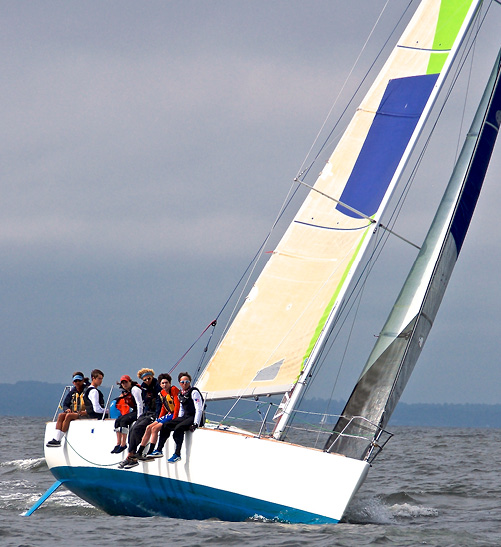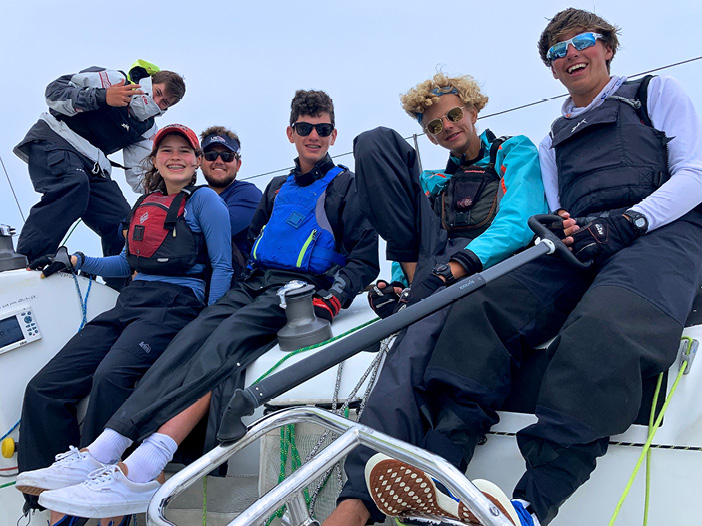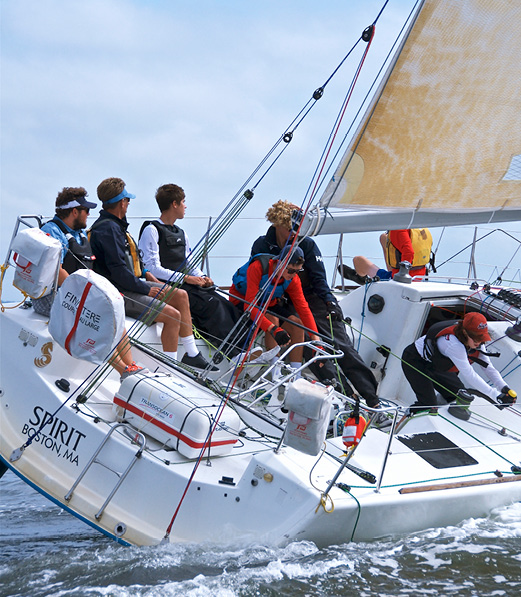By Rick Bannerot
This is the third installment in a series that started with the naive notion of telling the story of a 12-year-old Optimist sailor named Grace Sandoval, who was losing her passion for sailing. “I felt burned out,” Grace recalls. “I really disliked floating alone, in a little bathtub, with no breeze, being slowly broiled on Long Island Sound…Visions of blue swimming pools, playing tennis with my friends, volunteering at the local community garden, and doing musical theater danced around in my imagination. Anything would be better than going nowhere slowly in a dinghy.” Sailing had ceased to be fun for Grace, but then her story took a new path.

Grace Sandoval, aloft on Stamford Yacht Club’s chartered Beneteau Figaro 2 Spirit, was close to quitting sailing before she decided to try the give the club’s Junior Big Boat program a try. © Lawrence McGrath
In an effort to understand Grace’s frustration, the discovery process led the narrative down a circuitous path to a much bigger exploration of the dichotomy between being a burned-out pre-teen sailor at the same time kids just a few years older were jubilantly winning the Vineyard Race and the Newport Bermuda Race against much more experienced, very salty crews. How to tell such a story? Well, the illogical thing to do was start with the gaudy results story in WindCheck (windcheckmagazine.com/article/the-rise-rise-of-junior-big-boat-sailing/). The follow-up article, again not about Grace, looked at different paths that successful junior big boat programs were pursuing (windcheckmagazine.com/article/many-paths-one-common-goal/).
Back to Grace Sandoval, last seen being broiled alive and planning to pursue summer activities other than sailing an Opti. Her father, Matt Sandoval, is a former Naval officer, U.S. Naval Academy grad, and owner of the family’s Hanse 385 cruising sailboat. He was in a bit of a swivet over his daughter’s hard “NOPE” to sailing Optis again. After all, what was a supportive dad to do as he watched Grace’s interest in sailing slipping away?

Originally designed for singlehanded offshore racing, the 33-foot Spirit has supercharged junior big boat sailing at SYC. © Rick Bannerot/OntheFlyPhoto.net
Entering the narrative here is Lawrence McGrath, the recently appointed Sailing Director at Stamford Yacht Club in Stamford, CT. “Picture this,” said Lawrence. “I was in the middle of getting the new sailing instructors organized; working with the dock staff on coach boat maintenance issues; and talking with mothers that wanted to know whether their child should have SPF 30 or 60. Structurally, I was thinking, ‘Do we do two 4-week sessions, or do we offer a one-off 6-week session in addition to a more comprehensive summer-long session?’ I was also worried that I only had about eight weeks to also get junior sailors up-to-speed on sailing a big boat for the Dorade Trophy being hosted by our club.”
As part of his hiring, one of Lawrence’s tasks was to create a new paradigm around Stamford YC’s junior big boat program, both from a conceptual standpoint and a procedural one. Part of the motivation was that SYC has hosted and run the Junior Sailing Association of Long Island Sound’s Dorade Junior Big Boat Trophy Race for the better part of three decades, but frequently failed to field its own boat for the race. When it did, it usually involved parents who previously struggled with their adolescent children in the teaching process of becoming more familiar with the aspects of sailing a big boat, let alone racing one. This usually caused a scramble of borrowing a serviceable big boat and finding instructors skilled at teaching juniors how to race it. (As previously noted in this series, finding someone willing to toss the keys to a boat with the equivalent value of a Ferrari is a common dilemma.)
“I was sweating that our Ideal 18 fleet was only partially rigged for summer sailing due to a lack of parts, especially as the Ideals were integral to my new plans for 2021,” Lawrence continued. “One of my goals was to break down the perceived barriers that Opti sailors are supposed to sail Optis, 420 sailors should concentrate on 420s, and kids who aren’t into competitive racing, but have been enrolled by their parents, should just go for daysails on Ideal 18s. Oh, and I had to remember the new sailors’ names; which parent goes with which sailor; apply more sunscreen on my nose; review new budget items with the club’s CFO; say ‘Hello!’ to people I don’t even recognize, and smile more often.”
“In the middle of all this, Matt Sandoval walked up to me on the pier, introduced himself and his daughter Grace, and nicely asked if I thought she might be a possible fit for the revised and improved junior big boat program. Knowing the program was already fully subscribed, I was not quite sure what to say. I stammered out something about ‘always having room for sailors who want to learn, work hard, and have fun as we get up to speed on sailing skills and seamanship.’ It was probably one of the most fortuitous comments I made all summer. I had no idea where I’d put her, or what she could do, but that was exactly what Grace needed to hear. She looked me in the eyes and said, ‘I’d like that,’ at which point, to her father’s immense relief and credit, he turned to me and asked, ‘Now, what do we have to do to make the big boat program work?’”

From left to right are Oliver West, Cormac Murphy (coach), Grace Sandoval, Corey Guilfoyle, Jordi Helme, and Robbie Upton. © Lawrence McGrath
When a big boat could be borrowed, it was always a scramble to get enough junior sailors and instructors down to Larchmont Yacht Club for the Storm Trysail Foundation’s Junior Safety-at-Sea Seminar, a prerequisite to competing in JSALIS big boat races. A few evenings a month, in between JSA regattas, the borrowed boat, often a J/109, would go out for a training sail. Adult members with extensive racing experience graciously acted as mentors for these practice sessions and occasional Tuesday Night races, or had junior sailors-in-training join them for a weekend race in some other big boat, partially as observers, sometimes as crew. The big carrot at the end of the summer for the more skilled and enthusiastic juniors was often an invitation to sail with Commodore Hiro Nakajima and his adult crew of salty, bluewater sailors aboard Hiro Maru in the Vineyard Race and/or the Valeur-Jensen Stamford Denmark Race.
With Lawrence’s suggestions to enable what it would take to improve SYC’s modest program, support at the club was rallied from current and past flag officers, and the help of members like Jonathan Asch, one of the steadfast volunteer coaches and mentors through the years of up-and-down SYC Dorade initiatives. Jonathan identified and negotiated the charter of Spirit, a Beneteau Figaro 2.
With a dedicated big boat available for the whole summer, Lawrence’s more holistic approach was to then more quickly develop juniors by exposing them to a variety of boats. On any given day, depending on the weather, the best sailing platforms were chosen for the conditions and the skill level of the sailors. If there was no wind, it did not become a broil-fest. Instead, soccer and dodgeball were played on the back lawn, and pool relay races were the norm, mixed in with some whiteboard sailing discussions once young sailors’ energies were readjusted to a more manageable level.
At the other extreme, if it wasn’t quite blowing the proverbial dogs off their chains, instructors would load up Opti sailors and the more casual juniors enrolled in the “Adventure Sailing” group and take Spirit for a sail on Long Island Sound. Green Fleet Opti sailors that had not sailed on a big boat were frequently heard shouting about how cool and fun it was on Spirit, and that “It is like being on the ‘bestest’ roller coaster ever!”
As part of the new program, Ideal 18s proved to be excellent training platforms for young sailors to move about the boat, play the main and jib sheets, take the tiller, and feel the difference in speed and momentum of a V-shaped turn versus a C-shaped turn. Parents were encouraged to come down for the casual, non-spinnaker, family racing evenings at the club. Most were more than a little surprised at their young sailors’ rapidly expanding boat awareness, sensitivity to wind shifts, and comfort at the helm of a keelboat. “You could almost hear parents thinking, ‘Wait! What? My child was just messing around in Optis a month ago, and now she’s calling tacks and jibes in a keelboat?’” said Lawrence with a grin.
As the comfort and skill levels began to show on the water, sailors were introduced to the elements and nuances of flying a spinnaker on an Ideal with instructors like Cormac Murphy coaching them through the process. Cormac is an ISAF world-ranked 470 sailor and a rising star in Oakcliff Sailing’s Match Racing Program. “Cormac brought a nice calm to the teaching process and really related to each of the juniors in the big boat program,” said Lawrence. “He became my go-to coach for the Ideals and Spirit, and really helped the junior sailors find their own way on, in, and around the bigger boats.”

Team Spirit will be a threat on Long Island Sound in 2022. © Rick Bannerot/OntheFlyPhoto.net
In going through the process of learning on the Ideals, Grace especially liked the camaraderie of sailing with her newfound sailing friends. “Everyone was going through this together,” she said. We were trying things, for better or worse. We liked being given the chance to figure things out.”
“Grace found it fun to learn new skills, and took to all the challenges we threw at her; first on the Ideals and then on Spirit,” said Cormac. Of special interest were navigation and sailing tactics. She is good at math and liked learning the calculations for speed, wind, distance and Velocity Made Good. Grace made them into puzzles to solve, and she really took to these newfound challenges and responsibilities, learning how to do it more accurately, then faster. As a result, she earned the respect of her peers. Grace blossomed into the quiet heart and soul of the boat.”
One of the best things that happened to the sailors was after their Safety-at-Sea training at Larchmont YC, when everyone was having a quick swim off the transom of Spirit. The late afternoon wind swung southwest and picked up to 11-13 knots. The juniors jumped back aboard, soaking wet, slipped the mooring and quickly popped the kite on Spirit. Under the Beneteau’s symmetrical spinnaker, they spent the next three hours sailing back and forth on the Sound, every move talked through amongst themselves, and in consultation with Cormac and Lawrence. They experimented with different boat angles and the apparent wind, practiced keeping the kite full, and learned to burp the spinnaker pole to seamlessly change to a better angle while trundling along at good, better and best pace, depending on the different attempted combinations.
It proved to be a magical, confidence-inspiring training sail under extended, near-perfect teaching conditions. For many, it was a chance to change places on the boat, effectively boosting their sense of personal accomplishment, both as sailors and as a team. Unfortunately for Grace, she missed the experience of being in the zone with her teammates as she was picked up by car from Larchmont YC for a family commitment. (The good news is she had another chance to make up for the missed opportunity.)
As a final tune-up for the Dorade Trophy and the Beach Point Overnight Race, Spirit sailed down to Riverside Yacht Club for the 17th Annual YRA PHRF Regatta. Following the Larchmont experience, two days of racing around the buoys against a variety of adult-sailed boats helped boost the team’s experience and skills with starts, mark roundings, flying and dousing the spinnaker, running the sheets, repacking it, and doing it again. (It also gave Lawrence McGrath the confidence that his team was ready to sail in the next day’s Dorade…something that was not a foregone conclusion going into the Riverside weekend.)
Spirit sailed the Dorade Trophy at Stamford YC, and fought her way through a field of J/105s, J/109s, and John & Dorothy, another Figaro 2 out of Noroton Yacht Club. Against a stacked deck of one-design boats with more advantageous PHRF ratings and through their near-perfect boat-handling, the SYC team managed to claw their way to an improbable second place overall…Not bad for a bunch of kids that had never sailed – let alone raced – a Figaro 2 before June, especially one not optimized for windward-leeward racing.
Heading into their fourth consecutive day (and night) of warm summer racing was the Beach Point Overnight. Lawrence was concerned about their energy level, ability to effectively (and safely) perform assigned tasks, stay hydrated, and continue to function as a team. He underestimated the junior sailors’ reserves, and how much fun they were having. It didn’t hurt that they got into a twelve-hour duel through the night and early morning light with Noroton YC’s borrowed Figaro 2.
It was a classic punch/counterpunch duel between two evenly matched boats. With Grace calling the tactics, Spirit passed and got passed, pushed John & Dorothy out to mid-Sound, then sailed back against them to the Connecticut shoreline, always looking for better breeze and fairer currents. “It was some of the most technical and dramatic racing I have ever experienced,” Lawrence enthused. There were no raised voices; everyone did the tasks at hand; and positions and watches rotated like a well-oiled machine. Spirit was really well sailed, but Noroton just never gave us an inch. It was a thrilling, non-stop match, for the whole race. I could not be prouder of the team. While we may not have beaten them, our kids had fun, and learned a thing or three. From where we were in June, as far as I am concerned we won the summer.” ■
(Editor’s note: Look for the fourth installment in this series as we trace some of the other pathways to the waterfront for young people, especially those who are not members of a yacht club or have preconceived ideas about the social and economic hurdles that can and have precluded their apparent chance to experience the beauty and mystery of being on the water, let alone the joys and freedom of sailing.)



